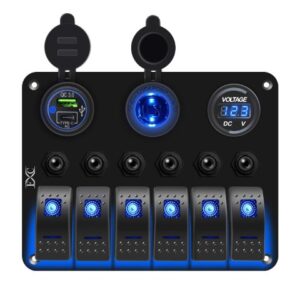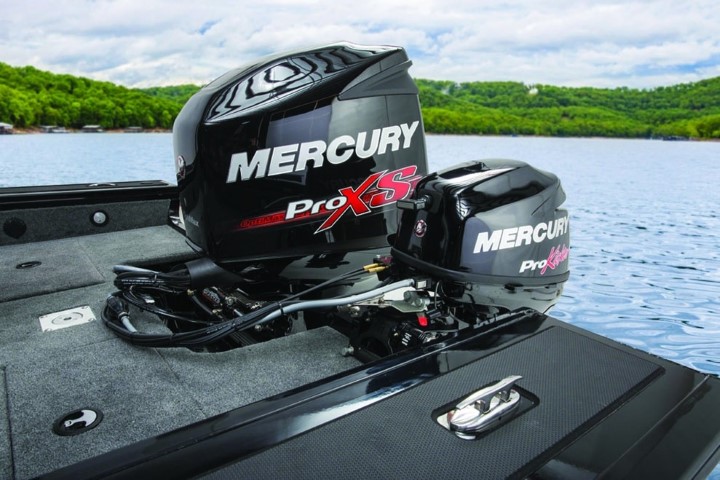When purchasing a used boat, it’s crucial to ensure that you’re making a wise investment. That’s why it’s important to have the engine hours checked by a reputable dealer, as this can provide valuable information about the boat’s overall condition. Additionally, a compression test should be performed to identify any potential issues with the engine. Furthermore, knowing the history of the previous owner can give you insights into how well the boat has been maintained. Checking for corrosion on zinc anodes, inspecting the prop and lower unit for damage, and looking for switches that don’t work are all important steps in assessing the boat’s maintenance. Plus, crawling under the boat to check for gouges or scratches that may cause leaks is essential. Don’t forget to inspect the trailer for rust, broken springs, and loose bunks, as well as the taillights and trailer wiring for any issues. While electronics can be easily replaced, it’s still worth checking their condition. Finally, be cautious of deals that seem too good to be true and take the time to thoroughly inspect the boat for any potential problems.
Engine hours should be checked by a reputable dealer
When considering buying a used boat, one of the most important factors to consider is the engine hours. The engine hours indicate how much the boat has been used, and can provide valuable insight into its overall condition. It is highly recommended that you have a reputable dealer check the engine hours for you, as they have the experience and knowledge to accurately assess the condition of the boat.
Why engine hours are important
Knowing the engine hours is crucial because it gives you an idea of how much wear and tear the boat has been subjected to. Just like with a car, a boat’s engine will inevitably experience wear and tear over time. The more hours on the engine, the more likely it is that the boat has been used extensively. High engine hours can indicate potential issues that may need to be addressed in the near future, such as engine repairs or replacement.
Benefits of having a reputable dealer check engine hours
Having a reputable dealer check the engine hours offers several benefits. Firstly, they have the tools and expertise to accurately read and interpret the engine hour meter. This ensures that you have reliable information about the boat’s usage. Additionally, a reputable dealer can also perform a more thorough inspection of the engine and other components, providing you with a comprehensive assessment of the boat’s condition.
How engine hours can indicate the boat’s condition
The engine hours can provide valuable insights into the boat’s condition. A boat with low engine hours typically indicates that it has been well-maintained and not excessively used. On the other hand, a boat with high engine hours may require more frequent repairs and maintenance. However, it’s important to note that engine hours alone should not be the sole factor in determining a boat’s condition. Other inspections and checks should be conducted to get a complete picture of the boat’s overall state.
Perform a compression test
Another important step when evaluating a used boat is to perform a compression test on the engine.
What is a compression test
A compression test involves measuring the compression pressure in each cylinder of the boat’s engine. By doing so, you can determine if the engine’s cylinders are in good working condition. The test involves removing the spark plugs and connecting a compression tester to each cylinder.
Importance of performing a compression test
Performing a compression test is crucial because it provides valuable information about the engine’s internal condition. The test can identify issues such as worn piston rings, leaking valves, or other compression-related problems. By detecting these issues early on, you can make an informed decision about whether to proceed with the boat purchase or negotiate repairs and maintenance into the price.
How to perform a compression test on an engine
Performing a compression test requires some technical knowledge and the right tools. It is recommended to have a professional mechanic or a reputable dealer perform the test for you. They have the expertise and the necessary equipment to accurately perform the test and interpret the results. A compression test typically involves removing the spark plugs, screwing in the compression tester, and cranking the engine to obtain the compression readings for each cylinder.

Consider the previous owner
When purchasing a used boat, it is important to gather as much information as possible about the boat’s history, including the previous owner.
The importance of knowing the previous owner
Knowing who the previous owner of the boat was can provide valuable insight into the boat’s overall condition and how it has been maintained. A well-cared-for boat with a conscientious previous owner is more likely to be in better condition than one that has been neglected.
What information the previous owner can provide
The previous owner can provide information about the boat’s maintenance history, any previous repairs or modifications, and any issues they may have experienced while owning the boat. This information can help you make an informed decision about the boat’s condition and potential future repairs or maintenance that may be required.
How the previous owner’s care can affect the boat’s condition
The previous owner’s care and maintenance of the boat can have a significant impact on its condition. A boat that has been regularly serviced, properly stored, and well-maintained is more likely to be in better overall condition. On the other hand, a boat that has been neglected or poorly maintained may have underlying issues that could lead to potential problems in the future. It is important to ask the previous owner about their maintenance routine and any known issues they may have faced.
Inspect the zinc anodes for corrosion
Zinc anodes are sacrificial metal devices installed on boats to help prevent corrosion. It is important to check for corrosion on the zinc anodes during a boat inspection.
Why corrosion on zinc anodes is a concern
Corrosion on zinc anodes is a concern because it indicates that the anodes are deteriorating and may need to be replaced. Zinc anodes play a crucial role in protecting the boat’s metal components from galvanic corrosion, which can cause significant damage if left unchecked.
How to check for corrosion on zinc anodes
To check for corrosion on zinc anodes, visually inspect them for any signs of degradation. Look for discoloration, pitting, or excessive wear. If the anodes appear to be significantly corroded, it is recommended to have them replaced by a professional.
The implications of corroded zinc anodes
Corroded zinc anodes may not provide adequate protection against corrosion, which can lead to damage to the boat’s metal components, such as the propeller, shaft, and through-hull fittings. It is important to ensure that the zinc anodes are in good condition and regularly replaced to maintain proper protection against corrosion.

Inspect the prop and lower unit
The prop and lower unit are critical components of a boat’s propulsion system and should be thoroughly inspected during the boat-buying process.
Significance of inspecting the prop and lower unit
The prop and lower unit play a crucial role in the boat’s performance and overall functionality. It is important to inspect them for any signs of damage or wear to ensure that they are in good working condition.
What to look for during inspection
During the prop and lower unit inspection, look for any visible damage, such as dents, cracks, or bent blades on the propeller. Additionally, check for any signs of oil leakage or excessive wear on the lower unit. Any issues found should be addressed and repaired before purchasing the boat.
Potential issues with a damaged prop or lower unit
A damaged propeller or lower unit can significantly affect the boat’s performance and maneuverability. A damaged propeller may reduce the boat’s top speed and fuel efficiency, while a damaged lower unit can lead to issues with gear shifting and leakage of lubricating oil. It is important to ensure that these components are in good condition to avoid future complications.
Check for malfunctioning switches
Malfunctioning switches can be indicative of poor maintenance and may cause operational issues with various boat systems.
Why malfunctioning switches indicate poor maintenance
Malfunctioning switches indicate poor maintenance because they can be a result of neglect or inadequate attention to the boat’s electrical systems. A well-maintained boat should have properly functioning switches, as they are essential for controlling various systems on the boat.
Common switches to check and their functions
Some common switches to check include the bilge pump switch, navigation light switches, and accessory switches such as lights, stereo, and livewell. Ensure that each switch operates correctly and controls the intended system or device.
How to identify malfunctioning switches
To identify malfunctioning switches, test each one by turning it on and off to ensure that the corresponding system or device functions properly. Pay attention to any switches that feel loose, do not respond, or show signs of corrosion. It is important to address any malfunctioning switches before purchasing the boat to avoid potential safety hazards or operational issues.

Crawl under the boat for inspection
Inspecting the underside of the boat is a crucial step in evaluating its overall condition and identifying potential issues.
Importance of inspecting the underside of the boat
The underside of the boat is often overlooked during inspections, but it can reveal important information about the boat’s condition. Crawling under the boat allows you to inspect the hull for any signs of damage, such as gouges, scratches, or cracks, which could potentially lead to water leaks or structural issues.
What to look for during the inspection
During the crawl under the boat, carefully examine the hull for any visible damage. Inspect the keel, chines, and strakes for any signs of impact or previous repairs. Look for areas where the gel coat may be worn or cracked. Additionally, check the condition of the boat’s through-hull fittings and ensure there are no signs of leakage or corrosion.
Potential issues that can be identified
Inspecting the underside of the boat can help identify potential issues such as hull damage, structural issues, or previous repairs. Identifying these issues early on allows you to make an informed decision about the boat’s condition and potential repairs that may be required.
Inspect the trailer
Examining the condition of the boat trailer is an important aspect of the boat-buying process.
Why inspecting the trailer is necessary
The trailer is responsible for transporting and storing the boat, making it an integral part of the overall package. Inspecting the trailer ensures that it is in good condition and capable of safely supporting and transporting the boat.
Key areas to check on the trailer
During the trailer inspection, pay attention to the condition of the trailer frame, axles, and suspension components. Look for any signs of rust or corrosion, which can compromise the trailer’s structural integrity. Check the tires for adequate tread and signs of dry rot. Additionally, inspect the trailer’s lights and wiring to ensure they are functioning properly.
Potential problems to look out for
Common problems with boat trailers include rusted or weakened frames, worn-out suspension components, and malfunctioning lights. A trailer in poor condition may not provide adequate support for the boat, leading to potential safety hazards during transportation or launching. It is important to address any issues with the trailer before finalizing the purchase.
Check the condition of electronics
While electronics are not typically a major concern when purchasing a used boat, it is still important to check their condition.
Why electronics may not be a major concern
Electronics on a boat are often easily replaceable and can be upgraded to newer models if desired. Therefore, minor issues with electronics should not be a deal-breaker, unless they are integral to the boat’s functionality.
Which electronics are easily replaceable
Electronics such as fish finders, GPS units, and VHF radios are commonly found on boats and can be easily replaced. These devices are often mounted using brackets or handheld, allowing for easy removal and replacement.
Other factors to consider regarding electronics
While some electronics may be easily replaceable, it is still important to assess their overall condition. Look for signs of damage, such as cracked screens or non-functioning buttons. Additionally, check the wiring connections to ensure they are secure and properly installed. If there are any major issues or concerns with the electronics, it is recommended to consult with a marine electronics specialist for further assessment.
Watch out for stress cracks in transom corners
Stress cracks in the transom corners can be a sign of significant structural issues and should not be taken lightly.
Why stress cracks are a major concern
Stress cracks in the transom corners can indicate significant structural problems that may compromise the integrity of the boat. These cracks are often a result of excessive stress or force being applied to the transom, potentially leading to water leaks or even failure of the transom.
How to identify stress cracks
To identify stress cracks, carefully inspect the transom corners for any visible cracks or fractures. Stress cracks are usually characterized by small, jagged lines that radiate outward from a central point. These cracks may be more pronounced when the boat is under stress, such as during a sea trial or while underway.
Consequences of stress cracks in the transom corners
Stress cracks in the transom corners should not be taken lightly, as they can indicate significant structural issues. If left unchecked, these cracks can worsen over time and result in water intrusion, which can lead to rotting of the transom or other structural damage. It is crucial to have a professional inspection and assessment if stress cracks are present to determine the extent of the damage and the necessary repairs.
In conclusion, when purchasing a used boat, it is important to thoroughly inspect various aspects of the boat to ensure its overall condition and functionality. Checking the engine hours, performing a compression test, and considering the previous owner can provide valuable insight into the boat’s history and potential issues. Inspecting components such as zinc anodes, the prop and lower unit, switches, the underside of the boat, the trailer, electronics, and watching out for stress cracks in the transom corners further ensure that any potential problems are identified before making a purchase. By following these steps and consulting with a reputable dealer or professional, you can make an informed decision and enjoy your boat with peace of mind.


